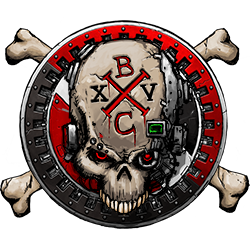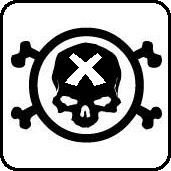-
Posts
360 -
Joined
-
Last visited
About Fahlnor

Fahlnor's Achievements
-
 SanguiniusJr reacted to a post in a topic:
Unit of the Week: Death Company Dreadnought
SanguiniusJr reacted to a post in a topic:
Unit of the Week: Death Company Dreadnought
-
Bit of threadomancy going on here, but worth mentioning that he would synergise better with a jump captain than with Dante. For the cost of Dante, you can bring Slamguinius and a jump pack Lieutenant. The bonus attack is arguably more valuable on Capt. Smash than on Dante; Dante’s reroll aura isn’t wasted on Sang Guard by combining with the Warlord rerolls; Sanguinor rerolls all his misses regardless thanks to the Cpt. aura; and the Lieutenant provides reroll wounds on everything, which you don’t have anything similar to if you bring Dante. :)
-
Good thoughts on weapon selection here, though as many are saying it will depend heavily on what you want the Stormraven to kill. In an ideal world, if you had access to any models available to Blood Angels, what would you put inside it?
-
Agreed. If you don’t take full advantage of the carrying capacity, you might as well bring Stormtalons or a Fire Raptor if your meta allows. But how do you do that? Would you bring Death Company or Vanguard Veterans on foot, knowing you have a good chance of placing them right where you want them, for example? Eschewing jump packs means doubling your model count in terms of transport capacity. Twelve Death Company definitely hit harder than six!
-
 Fahlnor reacted to a post in a topic:
How to get the most out of a Stormraven
Fahlnor reacted to a post in a topic:
How to get the most out of a Stormraven
-
 Drunken Angel reacted to a post in a topic:
Recent Games. The Value and Cost of Synergy is High
Drunken Angel reacted to a post in a topic:
Recent Games. The Value and Cost of Synergy is High
-
How do you use yours? Weapon load-out is always going to be dependent on what you need it to kill, but what do you put inside for special delivery? Is maximising infantry-carrying capacity worth the opportunity cost of mobility or durability for the troops? Given that you can conceivably add mobility via the Stormraven itself, perhaps we don’t need jump packs on the infantry it contains. Maybe having a relatively safe delivery system means that Terminator armour isn’t as necessary as it might be for teleporters or foot sloggers. What are your thoughts? What do you transport and why? How do you use them?
-

Recent Games. The Value and Cost of Synergy is High
Fahlnor replied to Drunken Angel's topic in + BLOOD ANGELS +
The value and cost of synergy were at the forefront of my mind when I was putting together my latest army list. I agree that synergies are vital to getting the most out of Blood Angels, but I’m concerned that creating too many buff zones isn’t the best use of our points. My thinking was that it may be worth investing into synergies specifically for one unit or unit type. What I mean by that is that by focusing your army on eg. Death Company, or Sanguinary Guard, or shooting units, you can spend fewer points on buffing characters and gain a net increase in your buff efficiency. Very simple examples: Lemartes is wonderful when run alongside Death Company, Death Company Dreadnoughts and a Death Company Captain; the Sanguinor, Sanguinary Ancient (with Standard of Sacrifice) and Sanguinary Priest seriously boost Sanguinary Guard; foot-slogging Captain/Lieutenant combinations make infantry and vehicle gun lines significantly more dangerous. So while we could spend our points on Lemartes and the Sanguinor and a foot-slogging Captain, perhaps it would be best to pick a particular unit type and focus on what we can do to really make that unit shine. The cost of spreading the buffs thin is two-fold: first is the literal cost in points, as these buffing characters are definitely not cheap; second is the efficiency cost of only having certain units fully benefit from each of the buff zones you pay for. I appreciate that this is more relevant to your post title than to your actual questions, but it’s been something which was on my mind recently and your thread seemed a good place to bring it up. What are your thoughts? Does a Sanguinary Guard unit reduce the value of having Lemartes in your list? Would you get more efficiency out of Astorath and more Death Company, rather than the Sanguinary contingent, for example? -

Change of Dynamic in Deployment and First Turn
Fahlnor replied to Fahlnor's topic in + BLOOD ANGELS +
That was essentially my conclusion, also. I put together an army list based on what I hope will be a synergistic collection of close assault units with six Scout Squads providing the bulk of the table presence. -

Change of Dynamic in Deployment and First Turn
Fahlnor replied to Fahlnor's topic in + BLOOD ANGELS +
Parabellum, I was t thinking of advertising the fact I want second turn to my opponent. Just working on the assumption that he or she will want first turn and looking for ways to turn that to my advantage. Perhaps we could create a mobile defensible position with eg. Land Raiders or Fortifications, populated by chaff such as Scouts. We can build all the deep strike screening we need and ensure there’s just nothing on the board which is either killable or valuable. Our opponent commits turn one and leaves themselves open to a counter-punch that tears them open from throat to groin. It just seems to me that deploying half for first turn and half for second turn without having any idea when you’re likely to play has to be a bigger risk than actively taking turn two and mitigating any first turn strike by our opponents. Perhaps a more palatable question would be “what is the best way for us to counter an alpha strike?” -
I’ve been thinking recently about how deployment and going first interact this edition compared to last edition and considering how to best adapt to the changes we’ve seen. Lets break the two editions down: 7e. 1. Roll off for deployment. 2. Players alternate deploying entire army. Whoever deploys first nominally gets first turn. 3. Roll to Seize the Initiative. 8e. 1. Roll off for deployment. Whoever wins the roll off deploys one unit first. 2. Players alternate deploying units until all units are deployed. 3. Roll off for first turn. Player who finished deploying all units first gets +1 to roll. 4. Roll to Seize the Initiative. So, what impact do we have from the changes? I think the following points are the most important: 1. 7e. gives both players an equal chance for deploying first and then allows the second player a chance to get the jump on their opponent by seizing. This is vital, because the first player to deploy does so with the understanding that they have a very high chance of having the first turn. They can prepare an alpha strike, etc., and they know that 5/6 times they will be able to use it. The second player has to decide: do I prepare to receive an alpha strike/counter my opponent’s deployment, or do I prepare a counter strike and hope to seize? 2. Without going into the maths, 8e. basically gives both players a 50% chance of going first, but requires both armies to deploy without knowing who will have the first turn. Seize the Initiative now holds significantly less tension because neither player has set up their army with the expectation of going first. Both players have to deploy much more tenatatively and can’t risk committing to many resources too far forward, because they’re as likely to go first as second. This impacts Stratagems such as Forlorn Fury quite significantly. So, where does this leave us? If we work on the assumption that our opponents want first turn (and will always choose it given the option), we can see two possibilities: if we also wish to go first, then there’s a simple 50/50 roll off with our opponent to see who does so. However, if we prep our army with a preference to go second, we’re in a wholly different scenario: we are guaranteed our choice of turn order and our opponent still has to deploy without knowing whether they’ll be first or second. Which leads to a final question at the end of a long and meandering post: how would you design your army differently if you knew you were going second?
-
 Morticon reacted to a post in a topic:
Ideal army composition
Morticon reacted to a post in a topic:
Ideal army composition
-
I'm not a fan of internet wisdom regarding which units are good and which aren't. I think that what is important is what your units can do and how you use them. To that end, I've decided to stay away from the "Flamer tacs aren't good", etc., which is often stated as fact here and elsewhere online. For example, see Lawrence Baker (Tabletop Tactics) winning No Retreat! with Dark Eldar in 7th, winning GW's GT Heat One with five Tactical Squads and placing well at 2018 LVO with around 90 Eldar Guardians. What I do think is valuable is evaluating how or why something works (or doesn't work). Your analysis doesn't touch on why you think the lists have been designed that way or how they are being used to best effect. At this point, your data is about as useful as noting that 37% of winning armies are painted red, or that 62% of winning armies contain no Finecast. I'm not going to say your list is good or bad, but I will say that your analysis so far doesn't seem to actually achieve anything. I would be very interested in hearing the results of further investigation, though. What is it about Troops which makes successful armies bring them? How are they being used? Why is 50% too large an investment in our Elites? Do all of the Elites function in the same way, perhaps? Maybe we are spending points on units which all do the exact same thing and are leaving ourselves exposed in other aspects of the game. What's the counter to the standard breakdown of lists? If winning lists tend to have large numbers of Troop choices, perhaps there's something we can start doing which would counter that element of the meta?
-
Same way you can make a DC Captain or outflank a unit of Space Wolves, I guess?
-
I've been contemplating bringing the DC Dread into the game with a Lucius Drop Pod. I'm thinking that a good-sized squad of Death Company can make use of either Forlorn Fury or Descent of Angels to put them in position for a first turn charge and, with careful placement of Lemartes and the addition of a couple of magna grapples, it should be realistically possible to put a couple of Dreadnoughts into vehicles at the same time. In fact, there's no reason why you couldn't also include the Death Company Captain with the second stratagem and the Angel's Wing and deny overwatch for whatever you're wanting to smash. Even without the Captain, it's very thematic and fits neatly into a Vanguard Detachment. So far as the Dreadnoughts are concerned, I'd be inclined to keep the storm bolter and meltagun to allow for some ranged damage output prior to the charge - this delivery would mean that heavy flamers are completely wasted so far as initial ranged attacks are concerned. I'd also think about using the Blood Talons, because I would want Lemartes to focus on buffing the squad. Letting the Dreadnoughts have a higher degree of autonomy means they can roam and rampage as needed, making best use of their 6" consolidation to wade further into the enemy lines and sow death and destruction as they go.
-
Hey all, I remember having a brief conversation on this forum a while back about Command Points and how to determine how many of them we need. I thought it might be worth bringing it to the wider community and seeing what the general mood is. Most discussions about Command Points seem to revolve around how we can get as many as possible and an assumption that we are astonishingly thirsty for CPs throughout our games. What I'd like to know is: if you were to strip them down and pare them back, how many would you be able to get away with and what would your priority be for using Stratagems? Let's assume a minimum of six Command Points - whether via a Battalion or a collection of eg. Vanguard/Spearhead detachments, six CPs should be pretty simple to get hold of. What are your priorities for spending them? Alternatively, what Stratagems do you think are absolutely necessary to the army and how do you go about getting enough Command Points to use them all?
-
I disagree - I would say that Tactical Squads fill a very different role and allow you to build a different type of list to Assault Squads. The problem Tactical Squads have is actually Intercessors, which fulfil a very similar role in an army. I would very happily compromise, however, and say keep Assault Squads in the Fast Attack section but give them ObSec - or move them to Troops but without ObSec - which would avoid them stepping on the current Troops’ toes.
-
They could seriously fix the problem of Assault Squads in an instant: make them Troops. Now I can take them to build an all-jump Battalion if I like, their mobility to cap objectives is more valuable, their limited damage output is irrelevant. I genuinely cannot see a single downside to allowing Blood Angels to take them as Troops again. It’s the single greatest tragedy of our Codex, in my opinion.
-
My issue is that the unit is pretty much entirely inferior to Company Veterans in terms of bringing in plasma weapons via deep strike, unless you specifically want five or fewer plasma shots for some reason. Five Assault Marines with dual plasma gun and a plasma pistol is 113 points. Five Company Veterans with jump packs, four with plasma guns and a plasma pistol is 154 points. So for a ~33% increase in points, you get an 80% increase in damage output. And if you are bringing in a Captain as previously suggested, the Company Veterans offer the ability to soak wounds for the character if needed.









